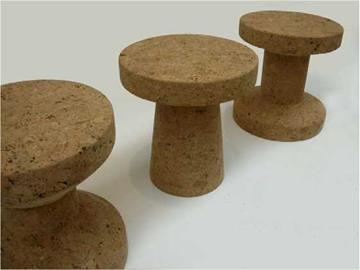 A material’s absorptive quality is its ability to absorb moisture, oils, and odors. Fabric and unfinished wood will absorb all three. Ring porous/semi-ring porous, open-grained woods, such as mahogany, can take a stain better than diffuse porous, closed-grained wood, such as hard maple; however, both woods can receive a deep-looking finish, but the processes may be different. Some woods are relatively high in oil content, such as teak, and are best finished using shellac. Others are remarkably dense, such as Gabon or Madagascar ebony, and have difficulty absorbing oil finishes. Cork is soft to the touch and will stain, but it is not absorptive. Jasper Morrison used cork as the primary material in his series of table stools produced by Vitra (Figure 7.11). These stools appear unfinished.
A material’s absorptive quality is its ability to absorb moisture, oils, and odors. Fabric and unfinished wood will absorb all three. Ring porous/semi-ring porous, open-grained woods, such as mahogany, can take a stain better than diffuse porous, closed-grained wood, such as hard maple; however, both woods can receive a deep-looking finish, but the processes may be different. Some woods are relatively high in oil content, such as teak, and are best finished using shellac. Others are remarkably dense, such as Gabon or Madagascar ebony, and have difficulty absorbing oil finishes. Cork is soft to the touch and will stain, but it is not absorptive. Jasper Morrison used cork as the primary material in his series of table stools produced by Vitra (Figure 7.11). These stools appear unfinished.
Granite is a type of igneous rock and will not absorb moisture or odors. It is remarkably dense, though sealing is suggested because bacteria can grow in the tiny pores of granite’s surface. Marble and limestone are both calcium carbonates, which will absorb moisture and oils, and are particularly susceptible to acids and to staining by olive oil.
Metals are generally considered non-absorptive Figure 7.11 Cork tables, designed by Jasper Morrison (2004) for Vitra. Photography materials, although they are affected by by Jim Postell, 2006.
atmospheric conditions and air quality. Oils and acids can affect metals. Some stainless steel metals will stain. Metals can be lacquered to preserve their appearance, but lacquer finishes on metal generally do not last; eventually, metal surfaces will oxidize. Powder coating is an effective alternative to consider as a finish for metals.



